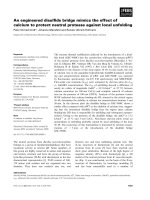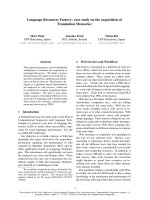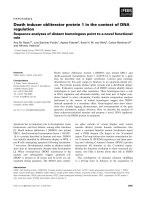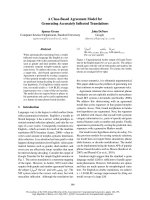Báo cáo khoa học: "No sampling technique was superior for the diagnosis of ventilatorassociated pneumonia" ppt
Bạn đang xem bản rút gọn của tài liệu. Xem và tải ngay bản đầy đủ của tài liệu tại đây (65.44 KB, 3 trang )
Available online at
Evidence-Based Medicine Journal Club
EBM Journal Club Section Editor: Eric B. Milbrandt, MD, MPH
Journal club critique
No sampling technique was superior for the diagnosis of ventilator-
associated pneumonia
Deanna Blisard,
1
Eric B. Milbrandt,
2
and Samuel A. Tisherman
3
1
Clinical Fellow, Department of Critical Care Medicine, University of Pittsburgh School of Medicine, Pittsburgh, Pennsylvania, USA
2
Assistant Professor, Department of Critical Care Medicine, University of Pittsburgh School of Medicine, Pittsburgh, Pennsylvania, USA
3
Associate Professor, Departments of Surgery and Critical Care Medicine, University of Pittsburgh School of Medicine, Pittsburgh, Pennsylvania, USA
Published online: 14 February 2005
This article is online at
/>© 2005 BioMed Central Ltd
Critical Care 2005, 9: E4 (DOI 10.1186/cc3491)
Expanded Abstract
Citation
Wood AY, Davit AJ 2nd, Ciraulo DL, Arp NW, Richart CM,
Maxwell RA, Barker DE: A prospective assessment of
diagnostic efficacy of blind protective bronchial brushings
compared to bronchoscope-assisted lavage, bronchoscope-
directed brushings, and blind endotracheal aspirates in
ventilator-associated pneumonia. J Trauma 2003, 55:825-
834.
1
Background
The diagnosis of ventilator-associated pneumonia (VAP)
has proven to be a challenging task. Studies comparing
invasive and non-invasive diagnostic approaches are
lacking.
Hypothesis
The use of a blind protected brush is equivalent to
bronchoscope-directed techniques in determining the
microbiology of VAP, while endotracheal aspirates are
contaminated with oropharyngeal flora and of little value.
Methods
Design: Single center, prospective cohort study.
Setting: Level 1 trauma center at an academic medical
center.
Subjects: Ninety trauma patients who were mechanically
ventilated for at least 48 hours and deemed to have clinical
indications suggestive of pneumonia (new infiltrate on chest
radiograph, excessive or purulent respiratory secretions,
suspected aspiration, fever (>38.2° C), leukocytosis
(>12,000/mm
3
), or respiratory distress of unknown cause).
Intervention: Four samplings were performed on each
patient in the following order: blind protected brush (BPB),
bronchoscopic-directed protected brush (BDPB),
bronchoalveolar lavage (BAL), and endotracheal aspirates
(ETA). Procedures were performed from least to greatest
degree of invasiveness to avoid contamination of lower
airways, except for ETA.
Measurements: With patients serving as their own controls,
quantitative cultures were obtained using each sampling
technique. BDPB and BAL were set as the "gold standards"
for comparison against each other and with BPB and ETA.
Kappa analysis was used to measure the strength of
agreement between techniques. Results were stratified by
type of organism.
Results
BPB had the highest strength of agreement with both BAL
and BDPB (κ=0.547 and κ=0.467, respectively). The
strength of agreement between techniques was moderate to
good for gram-negative cocci and fair to poor for gram-
negative rods and gram-positive cocci. Comparing the
growth of specific pathogens, Haemophilus, Klebsiella,
Escherichia, Acinetobacter, and Streptococcus correlated
well across the majority of techniques, while Enterobacter
agreement was consistently poor to fair.
Using BDPB as the gold standard, BPB was found to have
the highest sensitivity (91.1%) and specificity (89.8%).
Sensitivities overall were higher when using BAL as the gold
standard across all modalities. Kappa analysis comparing
blind samples obtained from the same vs. the opposite side
of the radiographic infiltrate found no differences between
sides.
Conclusion
A quantitative analysis of bacteriologic cultures obtained by
four standard sampling techniques demonstrated with
statistical significance that no difference exists between
Critical Care February 2005 Vol 9 No 2 Blisard, Milbrandt, and Tisherman
techniques in terms of reliability or obtaining clinically
significant pathogens.
Commentary
VAP is a common disorder, occurring in 8-28% of
mechanically ventilated patients with an associated morality
rate of 24-50%.
2
The diagnosis of VAP has proven to be a
challenge. Clinical indicators are neither sensitive nor
specific and culture data can sometimes be misleading due
to contamination and concurrent antibiotic therapy. There
are many publications supporting quantitative cultures for
the diagnosis of VAP, but studies comparing multiple
sampling techniques to determine the most sensitive and
specific method are lacking. This study attempted to
compare four of the most common diagnostic tests (BPB,
BDPB, BAL, ETA) to determine which is most reliable yet
least invasive. The authors determined that there were no
significant differences between the bronchoscopic and
nonbronchoscopic techniques. They were careful to note,
however, that while positive cultures appear to be reliable, a
negative culture does not necessarily rule out infection.
Thus, when a negative culture is obtained, and clinical
suspicion for VAP persists, repeat sampling may be
warranted.
This study has a number of strengths, including using each
patient as his own control, using explicitly defined criteria for
quantitative culture positivity, and stratifying results by
organism. However, this study suffers from the same
problem that all studies in this area do: the lack of a true
gold standard. To be sure, the authors used what many
believe are the most reliable bronchoscopic techniques
(BDPB and BAL) as gold standards, but even these
methods are not 100% sensitive or specific. It has been
suggested that only the combined results of histological
examination and quantitative cultures of lung tissue are
strong enough to rule in or rule out VAP in patients who
have been mechanically ventilated for more than 3 days.
3
Clearly, such a highly invasive sampling approach would not
be practical in all patients. Without an indisputable and
easily obtainable reference, calculations of sensitivity and
specificity will remain problematic.
A few additional limitations of this study deserve mention.
The sampling techniques were always performed in the
same order, potentially biasing the results; concern is raised
about contamination by the earlier tests causing false
readings in the later ones. Blind non-bronchoscopic BAL
(mini-BAL), a technique that has recently gained in
popularity, was not included. Few details are given
regarding the study population, limiting our ability to
determine if these results apply to other patient populations.
Given that a true gold standard is unlikely to emerge,
investigations have shifted from trying to determine which
technique can best diagnose VAP to which diagnostic
strategy leads to improved outcomes, such as morbidity,
antimicrobial use, and mortality. Four studies have sought to
determine if invasive strategies improve VAP outcomes.
4-7
Each study used a different design and had important
methodological limitations.
8
A recent meta-analysis pooled
the results of these trials, concluding that invasive sampling
approaches do alter antibiotic management, but do not
appear to alter mortality.
9
The authors were careful to note,
however, that the combined sample size may still have been
too small to detect important clinical outcome differences.
Recommendation
Until compelling data are produced showing a particular
sampling technique is superior, we recommend a VAP
management strategy
8,10
that includes: a) initial evaluation
with quantitative microbiology of respiratory secretions and
immediate initiation of antimicrobial agents, and b)
reevaluation within 2 to 3 days with adjustment or
discontinuation of antimicrobials based on clinical course,
culture results, and whether any noninfectious or
nonpulmonary etiologies have been identified.
Competing interests
The authors declare that they have no competing interests.
References
1. Wood AY, Davit AJ 2nd, Ciraulo DL, Arp NW, Richart
CM, Maxwell RA, Barker DE: A prospective
assessment of diagnostic efficacy of blind protective
bronchial brushings compared to bronchoscope-
assisted lavage, bronchoscope-directed brushings, and
blind endotracheal aspirates in ventilator-associated
pneumonia. J Trauma 2003, 55:825-834.
2. Ost DE, Hall CS, Joseph G, Ginocchio C, Condon S,
Kao E, LaRusso M, Itzla R, Fein AM: Decision analysis
of antibiotic and diagnostic strategies in ventilator-
associated pneumonia. Am J Respir Crit Care Med
2003,168:1060-1067.
3. Chastre J, Fagon JY: Ventilator-associated pneumonia.
Am J Respir Crit Care Med 2002, 165:867-903.
4. Fagon JY, Chastre J, Wolff M, Gervais C, Parer-Aubas
S, Stephan F, Similowski T, Mercat A, Diehl JL, Sollet
JP, Tenaillon A: Invasive and noninvasive strategies for
management of suspected ventilator-associated
pneumonia. A randomized trial. Ann Intern Med 2000,
132:621-630.
5. Ruiz M, Torres A, Ewig S, Marcos MA, Alcon A, Lledo
R, Asenjo MA, Maldonaldo A: Noninvasive versus
invasive microbial investigation in ventilator-associated
pneumonia: evaluation of outcome. Am J Respir Crit
Care Med 2000, 162:119-125.
6. Sanchez-Nieto JM, Torres A, Garcia-Cordoba F, El-
Ebiary M, Carrillo A, Ruiz J, Nunez ML, Niederman M:
Impact of invasive and noninvasive quantitative culture
sampling on outcome of ventilator-associated
pneumonia: a pilot study. Am J Respir Crit Care Med
1998, 157:371-376.
7. Sole Violan J, Fernandez JA, Benitez AB, Cardenosa
Cendrero JA, Rodriguez de Castro F: Impact of
quantitative invasive diagnostic techniques in the
management and outcome of mechanically ventilated
patients with suspected pneumonia. Crit Care Med
2000, 28:2737-2741.
2
Critical Care February 2005 Vol 9 No 2 Blisard, Milbrandt, and Tisherman
8. Torres A, Ewig S: Diagnosing ventilator-associated
pneumonia. N Engl J Med 2004, 350:433-435.
9. Shorr AF, Sherner JH, Jackson WL, et al. Invasive
approaches to the diagnosis of ventilator-associated
pneumonia: A meta-analysis. Crit Care Med 2005,
33:46-53.
10. Grossman RF, Fein A: Evidence-based assessment of
diagnostic tests for ventilator-associated pneumonia.
Executive summary. Chest 2000, 117:177S-181S.
3









